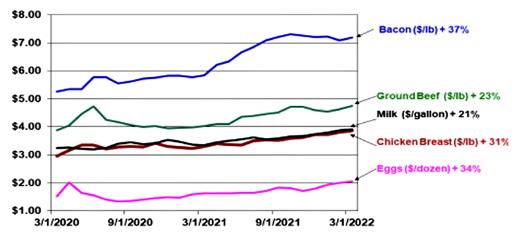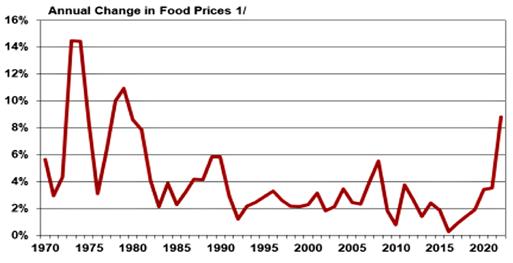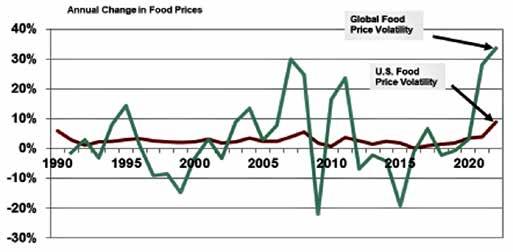
12 minute read
Economic & Policy Update
Food Price Inflation – Trends and Implications for U.S. and Global Consumers
Will Snell University of Kentucky
Inflation dominates today’s conversation among the media, politicians, and everyone impacted–i.e., all of us as consumers. Inflation is defined as a general rise in prices which causes a decline in purchasing power of consumers and producers over time, holding all other factors constant. Some “analysts” would argue that it represents a “tax” on consumers when it evolves from government actions such as expansionary fiscal or monetary policies. Inflation can originate from a series of events in the marketplace such as supply chain disruptions or a significant improvement in consumer demand conditions. A relatively moderate level of inflation is generally viewed by economists as “good” reflecting a healthy and growing economy. However, a sustained period of rapidly rising prices can produce devastating outcomes on many market participants and the overall general economy. Our January 2022 newsletter article titled Inflation – “Good” or “Bad” for Agricultural Producers and Consumers? focused primarily on the effects of rising prices on ag producers where the outcome of inflation on farmers may be mixed depending on a variety of factors. This article highlights the effects of inflation on ag (i.e., food) consumers and compares food price inflation in the U.S. versus global consumers. The chief measure of inflation in the United States is the Consumer Price Index (CPI), which is released monthly by the Bureau of Labor Statistics (BLS). Food is a major component of the CPI, comprising 13.4% of the index -- 8.2% for food purchased for at-home consumption versus 5.2% for food purchased away-from-home. [1] The latest CPI report (released April 12, 2022) indicated that U.S. consumer prices have increased 8.5% over the past twelve months, with energy prices being the major contributor, up 32% over the past twelve months and food prices up 8.8% since March 2021. Excluding the volatile energy and food sectors, overall U.S. inflation was lower, coming in at 6.5% over the twelvemonth period. Unlike some consumer items such as travel, home remodeling, or new automobiles, which can be delayed or eliminated from purchasing decisions during inflationary periods, food is a necessity. While consumers can substitute lower priced items at the grocery store (e.g. ground beef versus steak) or downscale dining options away from home (e.g., fast food restaurants versus casual/sit-down restaurants), consumers will still need to purchase or have access to food several times daily, even in midst of rising prices. Consumer research indicates that food price inflation has a greater impact on the lower-income consumers who generally spend a much larger percentage of their disposable income on food. According to USDA data, U.S. households with the lowest 20% of income spent 27% of their income on food in 2020 versus only 7% among the top 20% of income-earning U.S. households. Unfortunately, higher food prices may induce some lower-income consumers to avert other critical purchasing decisions such as routine health care visits, prescriptions, or insurance coverage in order to feed their families. It also elevates food insecurity among many segments of the population, increasing the need for food assistance programs and access to food banks. Plus, higher food prices contributing to a hike in overall inflation may induce action by monetary authorities to raise interest rates, hurting those who borrow money or depend on income from investments adversely impacted by rising interest rates. I tell students in my Food and Ag Marketing Course that during their lifetimes they have never really experienced any noticeable degree of inflation, especially food price inflation until the past couple of years. From 2000 to February 2020, food price inflation in the U.S. averaged 2.4% annually. In fact, we had several months during this period of food price deflation where aggregate food prices actually fell. However, we all know the environment has changed drastically over the past two years. During the early months of the Covid-19 pandemic, food price inflation in the U.S. was fairly modest due to adequate supplies of most food items (with some meats being an exception) and fairly intense retail market competition. From March 2020 to March 2021, U.S. food prices increased 3.4%, but have increased another 8.8% over the past twelve months – the highest annual increase in U.S. food prices since 1981. While very alarming to most consumers, the current level of food price inflation is nowhere near the levels experienced for several months during the early 1970s when U.S. consumers faced annualized food price inflation exceeding 15%.[2] Since March 2021, food-at-home (primarily grocery store purchases) increased 10% -- the largest twelve-month increase since March 1981, while food away-from-home (primarily restaurant purchases) increased 6.9%. Meat prices led the way with beef prices up 16.0% over the past twelve months, followed by pork, 15.3% higher, and poultry up 13.2%. Cereal and bakery product prices were 9.4% higher, while fruits and vegetables prices were up 8.5%, and dairy prices up
The Agricultural Economics Department publishes the Economic and Policy Update towards the end of each month. Each issue features articles written by extension personnel within the department and other experts across the country. Topics will vary greatly but regularly include marketing, management, policy, natural resources, and rural development issues. If you would like to recieve this newsletter by email, please contact Kenny Burdine at kburdine@uky. edu. You can also view current and past issues online at
https://bit.ly/2PoHsZj
Co-editors: Kenny Burdine, Alison Davis, and Greg Halich
7.0%. USDA projects that overall food prices will increase between 5 and 6% in 2022. Over the past two years, there have been a wide variety of factors contributing to higher food prices, including labor challenges, escalating fuel costs, a lack of truck drivers, port congestion, plant closures, and other issues leading to supply chain disruptions, along with rising ag commodity/input prices, weather events, disease outbreaks, and more recently the food production/trade impact of the Russian invasion into Ukraine. Collectively, Russia and Ukraine represent over 30% of the global wheat exports, nearly 20% of global corn exports and account for over 10% of global caloric consumption. In addition, this area of the world produces a lot of the ingredients used in the production of fertilizers. The ongoing war is affecting the production and distribution of fertilizers worldwide, limiting availability and putting additional upward pressure on global fertilizer prices which were already soaring prior to the invasion. Russia is also a major energy producer/exporter causing additional upward pressure on global fuel prices. Given higher input costs, lack of access to inputs, trade disruptions, and a war playing out, Ukraine ag/food production and trade is expected to be down 20% or more in 2022, contributing to soaring crop prices, escalating global food price inflation, and causing much concern over food security and famine in parts of Europe, Africa, and Asia that were already reeling from Covid-19 effects. While food price inflation in the U.S. has hit 40-year highs exceeding 8.5%, global food price inflation for the past twelve months is up more than 30% according to the latest data from the United Nation’s Food and Agriculture Organization (FAO). Food price inflation has a much greater adverse impact on consumers in lower-income nations where food may account for 25 -50% or more of consumer income versus less than 10% in the U.S. Figure 3 illustrates that global food prices tend to be much more volatile than U.S. food prices. One major factor contributing to this observation is that food in other parts of the
CONTINUED ON PAGE 18 Source: Federal Reserve Economic Data (FRED). 1/ Notes: 2022 data reflect changes in prices from March 2021 to March 2022

Figure 2: Prices of Selected Food Items (March 2022 vs March 2020)
Source: Federal Reserve Economic Data (FRED) using data from the Bureau of Labor Statistics (BLS)
Figure 3: Food Price Volatility: U.S. vs Global (1990-2022)

Source: Federal Reserve Economic Data (FRED), and Food and Agriculture Organization (FAO) Food Price Index Note 2022 data based on March 2021 - March 2022 period.
[1] Prior to the Covid-19 pandemic, the weight for food prices as part of the CPI was very similar (13.8%), but was split more evenly between food-at-home (7.6%) vs foodaway-from-home (6.2%). [2] U.S food price inflation averaged 7.8% during the decade of the 1970s versus 4.6% during the 1980s, but has been rather benign over the past three decades (averaging 2.8% during the 1990s, 2.9% during the 2000s and 1.7% during the 2010s). [3] According to the USDA, the farm value of the retail food dollar in the U.S. is around 15 cents vs exceeding 50% of the retail value in some poverty-stricken nations. [4] The FAO cereal price index reflects a 37% increase since March 2021.
world tends to be processed less compared to the U.S. resulting in retail food prices in those markets being impacted more by changes in ag commodity prices versus the U.S.[3] In addition, food consumers outside the United States generally consume more calories at home versus U.S. consumers where the cost of food for home consumption is more dependent on changes in ag commodity prices. Plus, marketing efficiencies, market competition, less yield variability, and availability of storage capacity present in the U.S. enables U.S. food prices to be less affected by changes in global commodity prices compared to consumers in many developing nations. As an example, farm-level wheat prices have soared 50-75% or more in recent months given recent geopolitical events resulting in higher prices for many bakery products using wheat as a main ingredient. According to USDA data, prior to the recent run-up in wheat prices, the farm value of bread in the U.S. was only around 5 to 9 cents per one pound loaf. Thus, a 50-75%% increase in wheat prices alone would only add a few pennies to the cost of bread for a U.S. consumer. CPI data reveal that U.S. white bread prices have increased 8 cents/ loaf or (5.3%) over the past twelve months, reflecting not only higher wheat prices, but also higher transportation, packaging, and labor costs. This compares to news reports indicating that bread prices have increased 25 to 50% or more in some global markets since the Russian invasion.[4] This situation is given to a rise in panic buying, black markets, government corruption, and fear of riots which have historically occurred in some vulnerable markets given sudden large hikes in food prices and food shortages. In addition, the International Monetary Fund (IMF) expects global economic growth to slow significantly this year (3.6% versus 6.1% in 2021) as the repercussions of the war in Ukraine spread worldwide and nations feel the effects of rising inflation and interest rates. Globally, the IMF is projecting that food prices will increase 14% in 2022. Unfortunately, the global food inflation/ food crisis will be magnified in the coming months if the war in Ukraine drags on for a significant period of time and global grain supplies outside of the Black Sea region do not respond to current price incentives or we observe significant adverse weather events in other grain-producing areas.
3 Tips for Farm Management During Rising Inflation
Jennifer Rogers University of Kentucky
With input prices on the increase and so many things changing with our economy, it is important that producers think about how to manage during rising inflation. There is nothing that we can do to control the prices that we have to pay for products, we can only make sound management decisions about what we purchase and how we manage cash, and the cost of money that is borrowed. 1. Hold onto Cash Many grain producers currently have more cash on hand than in the past. A phenomenal growing season last year, coupled with increasing prices for stored crops helped to create this cash influx. Many times when there is excess cash available, producers look for ways to use that cash to benefit them over the long run. Producers may be tempted to pay off some long-term debts or pay cash for large capital purchases. During this current environment, it may be wise to hold onto larger reserves of cash. The high input prices associated with the 2022 crop and the current uncertainty around getting the crop planted have caused much stress over this year’s crop being able to cash flow. Therefore, cash reserves may be needed to offset any shortfalls in being able to pay back associated expenses. Having cash reserves will potentially prevent, or limit, the need to refinance operating expenses over a longer period. 2. Lock in Interest rates Interest rates are on the rise as well. This typically means that any long-term debt that you have now, may be at a cheaper rate than you could borrow money for in the future. Therefore, there is less incentive to pay off debts at these low rates to turn around and need to borrow money at a higher rate. If you have term loans that are not at a fixed rate, or that will have to be refinanced for a balloon payment in the next few years, it may be wise to talk with your lender about locking in these rates now. Securing lower interest rates for the future could save your operation a substantial amount of interest cost over the life of the loan. 3. Operating Efficiently Operating efficiently is key during times of rising costs. We have already seen this to be vital in regards to fertilizer. All fertilizer costs have increased dramatically over the price paid for last year’s crop. This has caused producers to be prudent about how much fertilizer they intend to put on the crop. Decisions have been made about the rate applied. Some producers have even decided to use some of the “excess” fertility that they have been banking over the past. Efficiency is also needed in labor resources. Good farm labor is becoming harder and harder to find and even more expensive to keep. Make sure you are using your labor to their best ability. As hard as the decision can be to eliminate positions, it may be necessary. Efficiency can also be applied to machinery. Not only does the size of the equipment make it efficient, but also the need for equipment. Evaluate your mechanical needs. If there are idle pieces of equipment sitting around the farm, you may need to look into selling them. This will provide an additional source of cash and also eliminate insurance and upkeep expenses. Your farm business is just that, a business. You should always be looking for ways to operate at a lower cost while maintaining your profitability goals. Operating and thriving during a time of rising inflation is difficult. We have all either lived through or heard the horror stories of farming in the 80’s when inflation was high and interest rates were through the roof. Thankfully, we have the benefit of learning from that experience and can start making decisions now that will help manage the risk that we face.





